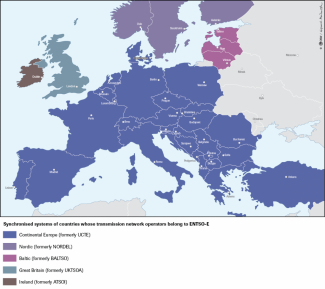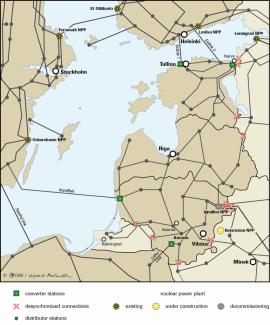EU support for synchronising the Baltic states’ power grids
On 23 January the EU allocated €800 million from the Connecting Europe Facility (CEF) financial instrument to the implementation of key energy projects. €323 million of this amount was earmarked for Lithuania, Latvia and Estonia as funding for the first three stages of a project to synchronise the Baltic states’ power grids with networks in the synchronous area of Continental Europe (the UCTE system, which covers the countries of Western and Central Europe). The planned cost of the work associated with the first stage of preparations for synchronisation, as included in the application to the EU, is €432.5 million (€167 million for Lithuania, €77 million for Latvia, and €187 million for Estonia). The amount of €323 million is therefore the maximum possible support for an EU project, namely 75% of the total costs. It is also one of the highest subsidies for a network synchronisation project in the EU.
The synchronisation process is to be completed in 2025. The Baltic network will be synchronised with the UCTE system using the existing connection between Poland and Lithuania (the LitPol Link). At the request of Estonia and Latvia, the integration of the Baltic and European networks will be bolstered by the construction of a new maritime connection between Poland and Lithuania (Lithuania had sought to build up the ground connection with a parallel line, but then withdrew the proposal). The synchronisation process will be preceded by the desynchronisation of the Baltic networks from those in Russia (including the Kaliningrad region) and Belarus.
Although the operators in the Baltic states are members of the European Network of Transmission System Operators for Electricity (ENTSO-E), their electricity networks still operate within the post-Soviet IPS/UPS synchronous transmission system, which is centrally directed from Moscow. In 1999 Latvia and Estonia, and in 2001 Lithuania, signed the BRELL agreement to remain in the synchronous system with the Russian and Belarusian networks. The BRELL agreement is the last element binding the Baltic states’ energy systems to the post-Soviet space. During this time, the Baltic states have had no trans-border connections to either the Nordic countries’ system (the Nordel system), or to Continental Europe via Poland; their networks were an element of the systems of Russia and Belarus. At present, there are now asynchronous links via undersea cable from Estonia to Finland (Estlink 1 and Estlink 2), and from Lithuania to Sweden (NordBalt), as well as by land line from Lithuania to Poland (LitPol Link), which influenced the decision to desynchronise from IPS/UPS. The Baltic states have also launched the Baltpool joint electricity exchange market. Transactions therein may also be conducted by entities from neighbouring countries with which Lithuania, Latvia and Estonia have electricity interconnections. The Baltic states can now become independent in terms of energy production. However, in Lithuania such independence would involve a considerable increase in the consumption of imported raw materials, as well as higher energy prices. Vilnius has chosen to import energy from Estonia and Latvia, the Nordic countries, and Russia & Belarus (exclusively via the Baltpool exchange), and to transformation its energy production system in the direction of renewable energy sources; 72.4% of the energy consumed in the country in 2017 was imported.
Commentary
- The political agreement between the three Baltic states & Poland and the European Commission on synchronisation with the countries of western and central Europe was agreed on 28 March 2018. This allowed the Baltic states to apply for funding for the synchronisation project from the CEF instrument before the end of the current multiannual financial framework, which will speed up its implementation. One of the most important problems, in addition to the technical issues of the synchronisation and desynchronisation processes, was justifying the high cost of the project (c. €1.5 billion). Synchronisation is not a project which generates direct economic gains that can compensate for the expenditure on the entire process. It is primarily a political project, integrating EU states and securing the Baltic states’ systems against unwanted actions by Russia. The maximum 75% of support confirms that the EU also perceives the synchronisation project as a priority undertaking, which will lead to the creation of an energy community within the EU.
- The high level of support in the project’s first stage will give the Baltic states hope that a similar level of funding will be maintained over the next two phases. In the second stage, the most important investment will be the construction of a maritime connection via electric cable between Lithuania and Poland. This investment will enhance the Baltic states’ energy security after desynchronisation from the Russia/Belarus system. A series of internal technical tests should answer the question of whether it will be necessary to develop new generating capacity in the Baltic countries (Lithuania has estimated its need at around 300 MW) or in cooperation with Poland, which is a key partner for Lithuania, Latvia and Estonia in the synchronisation project.
- Thanks to the European Commission’s support, significant progress has been made in the desynchronisation process, which must take place in unison in order to ensure the stability of both parties’ power systems. The involvement of the European Commission is intended to de-politicise the process and limit the possibility of the synchronisation process being used as a tool of blackmail against the Baltic states, for example by attempts to destabilise their power systems. At the three Baltic states’ request, the European Commission took over responsibility for the talks with the desynchronising states, Russia and Belarus, which are essential for the project, as well as informing them of its progress at every stage. The project is also being supervised by ENTSO-E. This organisation is supposed to present the technical conditions for the synchronisation process and conclude an agreement with the Baltic states this year. The final decision to link these countries to the European continental system depends on these conditions being met.
- The Baltic states and Russia are both aiming to reduce the risk of instability in the systems which accompanies the synchronisation process. Moscow has for several years been intensively expanding its generative capacity and electricity interconnections in the Kaliningrad region, which should allow the system to operate stably in isolated mode. The first attempt to get the system to work in Kaliningrad, carried out in 2014, ended in failure. Since then, Russia has made significant investments in the region. Further tests by both sides of their preparation for desynchronisation – Russia in the Kaliningrad region, and the Baltic states – will involve new attempts to run the systems in isolated mode. Russia will carry them out in Kaliningrad on 24-26 May, and the Baltic states will do so two weeks later.
- Russia is still criticising the decision to desynchronise as unnecessary and overly expensive for the Baltic states (as seen in statements by President Vladimir Putin during the ceremony opening the LNG terminal in Kaliningrad on 8 January this year; and by the Russian energy minister Aleksandr Novak on 21 January after talks with the European Commission in Brussels, wherein he stated that the desynchronisation process was “inappropriate”/“unsuitable”). The EU’s large financial support for this project gives the Baltic states a serious counterargument; Lithuania’s energy minister Žygimantas Vaičiūnas pointed out that with such great support from the EU, synchronisation will not be a greater burden than the construction of the power link from Lithuania to Sweden. A further escalation of propaganda from the Russian side can be expected in May 2019, during the trials of the system in the Kaliningrad region in isolated mode. Russia’s decision to carry out these trials at that time is not accidental; during the tests Russia will not sell any energy on the Baltic energy market, which could lead to a temporary jump in energy prices for Baltic consumers. This could be exploited in campaigns by pro-Russian forces in the Baltic states as they challenge these governments’ policies towards Russia (elections to the European Parliament will be held on 26 May in Lithuania, Latvia and Estonia).
Appendix






